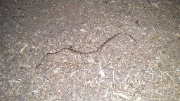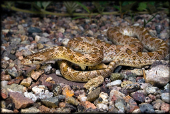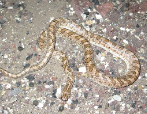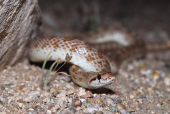Arizona Glossy Snake (Arizona elegans noctivaga)
Description: Adults 18–42 inches average total length (TL). A moderately slender snake with smooth shiny scales in 25–29 rows at mid body but most often numbering 27. The anal plate is not divided. The snout is slightly elongated, and the lower jaw is inset. The pupil of the eye is round but becomes slightly vertical when it is contracted. This subspecies has one or two preocular scales.
The basic coloration and pattern is composed of an average of 66 brown to dark brown body blotches with slightly darker colored borders over a light brown to reddish brown ground color. The blotches are the same width or slightly wider than the spacing between them. The total number of blotches can vary from 53–77. The venter is a uniform light tan or white in color. There is a mask-like brown line that bridges the top of the head from eye to eye and runs from the eye to the angle of the jaw on each side of the head.
Habitat: Habitat is normally semi-arid grasslands of the southwestern United States.
Range: Historical occurrence in USA: Arizona west and south of the Central Mountains, southeast into Cochise County, but excluding the Yuma Mesa and Yuma Desert. Mex: northwestern Sonora Mexico.
Found in these States:
AZ
Diet: A constrictor. Lizards are preferred prey. Snakes, small rodents and birds are also consumed.
Reproduction: Glossy snakes are oviparous. Adults breed in the late spring and early summer. Clutches average from 10 to 20 eggs. The eggs hatch in early summers and the newly hatched young are approximately 9.8 inches in total length.
Status: Listed as Least Concern in view of the large and probably relatively stable extent of occurrence, area of occupancy, number of subpopulations, and population size. This species is not threatened in most of its range.
»» Kingdom: Animalia - Animals
»» Phylum: Chordata - Chordates
»» Subphylum: Vertebrata - Vertebrates
»» Class: Reptilia - Reptiles
»» Order: Squamata - Scaled Reptiles
»» Suborder: Serpentes
»» Superfamily: Colubroidea
»» Family: Colubridae - Colubrids
»» Genus: Arizona
»» Species: Arizona elegans - Glossy Snake
»» Subspecies: Arizona elegans noctivaga - Arizona Glossy Snake
This article uses material from the Wikipedia article "Glossy Snake", which is released under the Creative Commons Attribution-Share-Alike License 3.0. Content may have been omitted from the original, but no content has been changed or extended.
|












